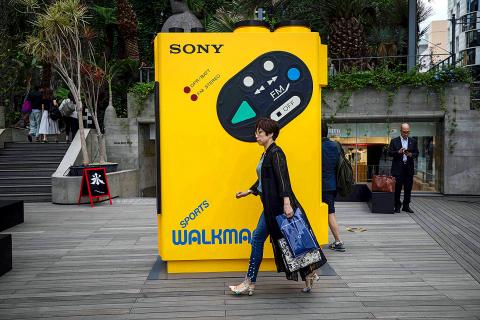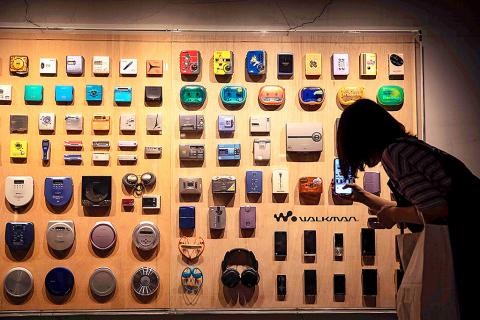Must-have 80s gadget and one-time icon of Japan electronics cool, Sony’s Walkman turned 40 this year and like its now middle-aged fans, is clinging to its youth with high-tech updates.
On July 1, 1979, as the global economy suffered through the second oil shock, Sony unleashed on the world a dark-blue brick of a machine with chunky silver buttons, the Walkman TPS-L2.
Priced at a hefty 33,000 yen — US$300 in today’s money — the first generation Walkman could not record but its stereo music playback function quickly captured hearts in Japan and then the world.

Photo: AFP
It had two headset jacks — labeled “guys” and “dolls” — to allow two people to listen simultaneously. A bright orange “hotline” button could be pressed to lower the volume while the couple chatted.
After a disappointing first month when only 3,000 units were sold, sales exploded to eventually hit 1.5 million worldwide for the first model. The second model, the WM-2, which came in red, black and silver, chalked up sales of 2.58 million.
Over the following four decades, Sony sold more than 420 million “Walkmen” and stopped counting the number of models it had produced when it hit the 1,000 mark — about 15 years ago.

Photo: AFP
The Japanese electronics giant chose the name partly because of the popularity of Superman at the time and the fact it was based on an existing audio recorder called the “Pressman.”
The word “Walkman” has since entered everyday language but the device was initially called “Soundabout,” “Stowaway” or “Freestyle” in some parts of the world.
“The Walkman is my youth,” said Katsuya Kumagai, now 51, as he browsed an exhibition to mark the 40th anniversary of the first edition.
“It was always in my life,” he added, scanning some of the 230 varieties of Walkman on show, which also offers nostalgic visitors the chance to play with some of the older models.
As an 11 year old, Kumagai could never afford a Walkman and envied older children as they whizzed by on roller skates plugged into the latest sounds.
“I’m quite emotional. Memories from those days are flooding back,” he said, echoing the thoughts of many a middle-aged fan for whom the Walkman provided the soundtrack to their youth.
‘PLAY AND PAUSE’
Sony continued production of the cassette-tape Walkman until 2010, long after the technology had been overtaken first by the Compact Disc in the 1980s and the MiniDisc Walkman in 1992.
Like many in the industry, the Japanese firm was shaken by the emergence of Apple’s iPod when suddenly a listener’s entire music collection was available on the move.
But Sony has scrambled to keep up and the latest high-end versions cost well over US$2,000 and look more like a smartphone with flash memory and high-res audio — a far cry from the early generations.
Scott Fung, a 17-year-old also attending the exhibition, has never known a time when people could not listen to music on the move and said he had “only heard” about the Walkman and was keen to satisfy his curiosity.
“Ever since I grew up, devices have always had screens and they don’t have physical buttons,” he said clutching his smartphone and gazing at the early Walkmen on display.
“When I was born, Sony Walkman was already not as relevant... [it] was not really a big part of my life,” said the student from Hong Kong who listens to music via his smartphone.
But perhaps surprisingly, he revealed himself to be a fan of the older tech.
“I think this older design is really intelligent where you can just play and pause, go back and forth in a song, which is very interesting to me,” he said.
‘IT’S SO COOL’
Fung is apparently not alone in his penchant for the old-school technology: a first edition Walkman presented as new and never used sold recently for 1.3 million yen, a mere 40 times its initial price.
Sony engineer Hiroaki Sato, who worked on the early Walkman editions, even said it would be “quite difficult” to replicate the technology now, as it would involve painstakingly reproducing high-precision components.
He said the current versions would likely not exist in 40 years as the recording formats and rechargeable batteries would undoubtedly have changed beyond recognition.
But the old Walkman has stood the test of time.
“Repairing this, I realized this is an excellent machine. If we replace the damaged rubber belt, it works normally. It’s so cool,” he said.

One of the biggest sore spots in Taiwan’s historical friendship with the US came in 1979 when US president Jimmy Carter broke off formal diplomatic relations with Taiwan’s Republic of China (ROC) government so that the US could establish relations with the People’s Republic of China (PRC). Taiwan’s derecognition came purely at China’s insistence, and the US took the deal. Retired American diplomat John Tkacik, who for almost decade surrounding that schism, from 1974 to 1982, worked in embassies in Taipei and Beijing and at the Taiwan Desk in Washington DC, recently argued in the Taipei Times that “President Carter’s derecognition

This year will go down in the history books. Taiwan faces enormous turmoil and uncertainty in the coming months. Which political parties are in a good position to handle big changes? All of the main parties are beset with challenges. Taking stock, this column examined the Taiwan People’s Party (TPP) (“Huang Kuo-chang’s choking the life out of the TPP,” May 28, page 12), the Democratic Progressive Party (DPP) (“Challenges amid choppy waters for the DPP,” June 14, page 12) and the Chinese Nationalist Party (KMT) (“KMT struggles to seize opportunities as ‘interesting times’ loom,” June 20, page 11). Times like these can

June 23 to June 29 After capturing the walled city of Hsinchu on June 22, 1895, the Japanese hoped to quickly push south and seize control of Taiwan’s entire west coast — but their advance was stalled for more than a month. Not only did local Hakka fighters continue to cause them headaches, resistance forces even attempted to retake the city three times. “We had planned to occupy Anping (Tainan) and Takao (Kaohsiung) as soon as possible, but ever since we took Hsinchu, nearby bandits proclaiming to be ‘righteous people’ (義民) have been destroying train tracks and electrical cables, and gathering in villages

Dr. Y. Tony Yang, Associate Dean of Health Policy and Population Science at George Washington University, argued last week in a piece for the Taipei Times about former president Ma Ying-jeou (馬英九) leading a student delegation to the People’s Republic of China (PRC) that, “The real question is not whether Ma’s visit helps or hurts Taiwan — it is why Taiwan lacks a sophisticated, multi-track approach to one of the most complex geopolitical relationships in the world” (“Ma’s Visit, DPP’s Blind Spot,” June 18, page 8). Yang contends that the Democratic Progressive Party (DPP) has a blind spot: “By treating any